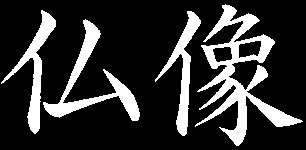|
Buddha Statues
Existing literature on Japanese gardening contains
an enormous amount of mis-information. Untrustworthy sources can include
public garden brochures, newspaper articles, internet sites, and even books
written by well-known authors. Below is a letter from a JOJG reader who
obviously encountered such mis-information. We shared her letter with a few
JN garden professionals. Their comments are posted here.
Dear JOJG,
I have been doing some Japanese garden research and have come across the
view that all Japanese gardens must have a statue of the Buddha. As a
Christian, I would much rather place a statue of the Virgin Mary or a large
Celtic Cross in memory of my mother. What is your view on this?
- Elizabeth Osborne, Lima, Ohio
 Bill Stufflebeem
Bill Stufflebeem
Placing Christian statuary in Japanese gardens is inappropriate and
in dubious taste. These items belong in cemeteries or the grounds of
religious buildings, not Japanese gardens. Parts of very old and worn
Buddhist stupas are very occasionally reused as waterbasins or garden
decorations. Such reuse of objects not originally designed as garden
ornaments is called mitate. This rarely seen and subtle practice is not a
justifiable precedent for using Christian images in Japanese gardens. If one
must have these statues, place them in non-Japanese areas of the garden.
Bill Stufflebeem is a garden designer and aesthetic tree pruner based in
Colorado.
 Bardwell Smith
Bardwell Smith
The viewpoints on what constitutes a Japanese garden expressed in
previous issues of JOJG (see July/August 1999) reveal genuine diversity but
also agreement that gardens at their best provide the viewer with no
specific meaning, let alone instruction. Religious and cultural symbols
paradoxically distract from a viewer’s ability to find meaning
independently.
The loveliness of a well-executed garden inspires; it does not need to
explain. Explanation limits what one derives from cumulative experience. As
we know, one need not gild the lily; the lily is self-expressive. By
imposing “meaning” upon the garden, one detracts from its deeper
significance, which cannot be put in words. One’s own words, or those of
another, interrupt the fullness of meaning which arises when we sense the
power of intrinsic harmony.
This is true, whether the symbols be Christian or Buddhist, Japanese or
Western. Even if one were to think in Christian terms, the sacredness of
creation need not be labelled. It is to be discovered, again and again.
Prof. Bardwell Smith is Professor Emeritus of Asian Studies at Carleton
College.
David Slawson
I would liken the view that “all Japanese gardens must have a statue
of the Buddha” to the conclusions reached by the six blind men touching
different parts of an elephant in the Indian fable; except in this case the
blind man is not touching the elephant, but rather a small ornament attached
to the elephant’s robe. The Japanese garden is, in a few words, a
nature-inspired landscape art, and its success does not hinge on including
statuary. In fact, such ornament is detrimental unless used with utmost
care.
When it comes to the use of ornaments in Japanese gardens, Samuel Newsom
sums it up in his book, Japanese Garden Construction: “People are sometimes
carried away by an object because it is old or has a history, regardless of
its suitability or artistic value.” He encourages us to include in our
gardens “only necessary things, or things which truly contribute to the
beauty of the scene.”
Think of ornaments in a garden as garnishes in gourmet cooking. They add
visual flavor, but they’re not the main meal.
David Slawson is a Japanese garden designer and author.
 John Powell
John Powell
While Shintoism and later Buddhism may have had an effect on the
evolution of the Japanese garden, their existence within the garden is
certainly not a pre-requisite. Outside of the gardens on temple grounds
devoted to religious pursuits, the presence of Buddha is only an illusory
effect used to motivate the senses of the garden viewer in some way. The
same can be said of other religious icons. This is not to say that such
elements have no place in the garden. Placed properly, these elements may
add to the viewer’s experience.
Ultimately, the joy and amazement of the garden is conveyed through the
placement of stones which accentuate their own character, the never-ending
course of water, and the expressive nature of plants. If the installation of
an element special to the owner is desired, so be it. For gardens not
connected with temples or in this case churches, placement of such elements
should be subdued to a quiet spot out of main view where their own spiritual
meaning may be realized upon discovery by the viewer.
John Powell is a professional Japanese garden builder from Weatherford,
Texas.
 David DeGroot
David DeGroot
I’m not sure what resource information was used, but I am very
surprised by the conclusion that “all Japanese gardens must have a statue of
Buddha.” In my visits to various gardens in Japan, I don’t recall ever
seeing a Buddha statue outside of temple grounds or cemeteries.
In maintaining bonsai from different countries, I frequently hear
conflicting observations, opinions, and advice from very respected artists.
It would drive me to confusion if I did not have the ability to analyze
which parts of their opinions were rooted in universal concepts, cultural
traditions, the fashion of the times, or their personal taste. Anyone’s
aesthetic sense derives from all four sources.
In this case, my first suggestion would be to simply forgo the use of
statuary altogether. If the writer is determined to include a Christian
statue, I would suggest a small, well-weathered image placed discretely in a
quiet corner. The idea of a large Celtic cross seems so far removed from the
Japanese garden aesthetic that I cannot recommend it.
David De Groot is the curator of the Weyerhaeuser Bonsai Collection.
Tamao Goda
First of all, gardening is not a religion. This is true whether it’s
done in Japan or anywhere else. The way you sweep a path or prune a tree has
nothing to do with religious faith.
Second, why do so many Westerners think it’s appropriate to place Buddha
statues in gardens? We Japanese people almost never do such things. Please
visit Japan and see for yourself. Look over the wall into private homes and
gardens. You will rarely, if ever, see a Buddha statue anywhere. In Japan,
such statues rest mostly in temples or museums, hidden in the depths of dark
buildings. Others are in cemeteries or by the roadside where someone was
killed in a car accident.
The fundamental goal of Japanese gardening is not about ornamentation. It is
to recreate the beauty of nature in that small, intimate space beside our
home. This process has nothing to do with religion, does it? Nature doesn’t
build statues.
It’s your decision, but I recommend you try to forget about religious
statues and just have fun in your garden. Good luck!
Tamao Goda is JOJG’s art director and chief Japanese garden researcher.
Conclusion
The paramount goal of a Japanese garden is to bring the beauty of
nature into the lives of ordinary human beings. This goal has nothing to do
with religion, and it is a mystery why Westerners continue to exaggerate the
role of religion in Japanese gardening. There is no need to have any statues
at all in a Japanese garden, and even functional ornaments like lanterns and
basins should be used in moderation.
But it is your garden, and it is important that you feel comfortable with
it. If you wish to include a statue of the Virgin Mary or a Celtic Cross,
you should do so. At that point you might want to start calling your garden
a “unique” Japanese garden rather than a traditional one. The traditional
aesthetic, of course, honors understatement and simplicity, and any
ornamentation should be as modest as possible.
--------------------------------------------------------------
